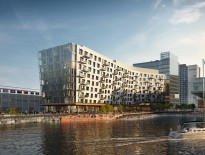Shortly after taking office in 2014, Boston Mayor Martin Walsh issued a detailed report entitled “Housing a Changing City,” with ambitious plans to create 53,000 new dwelling units in Boston by 2030 for a population expected to exceed 700,000 residents by that date.
This population increase will spur demand for workforce housing in a pricey city where many developers would rather build more profitable luxury housing. The mayor’s report acknowledges the need for private developers to deliver workforce housing, due to reduced state and federal funding. The report expects only 8,000 of the 53,000 new units to be city-assisted, with the remaining 45,000 built privately. The report forecasts that 4,000 privately developed units will be added through Boston’s Inclusionary Development Policy (IDP), which obligates developers to provide lower cost housing.
The IDP was introduced in 2000 for residential projects with 10 or more units requiring zoning relief (such as variances, conditional use permits or zoning amendments) or city assistance. The Boston Planning & Development Agency (formerly known as the Boston Redevelopment Authority) administers the IDP. Developers are expected to build on-site “affordable housing,” which is shorthand for price-controlled housing set aside for individuals with lower incomes. Developers of projects without affordable housing must provide off-site affordable housing, or substantial contributions to an affordable housing fund. The IDP originally required at least 10 percent affordable units on-site, 15 percent affordable units off-site, or contributions equal to $52,000 times 15 percent of the total units. The requirement for on-site units was later increased to 13 percent, and the contribution per unit was raised to $200,000.
The IDP has enjoyed modest success since its inception, creating over 1,700 affordable units and collecting $97 million in contributions. Jay Eigerman, a land use attorney representing developers subject to the IDP, notes that “the trick for Boston is not to set the affordable housing requirements so high that the market cannot deliver more housing.”
Goals Vary By Neighborhood
Following his 2014 report, Walsh issued an executive order directing Planning & Development to raise the off-site requirements and contributions per unit in pricier areas. The updated IDP establishes three separate zones with differing affordable housing requirements. Zone A covers the city’s most expensive neighborhoods, such as Back Bay, Beacon Hill and the North End. Zone B covers less expensive neighborhoods, such as Allston-Brighton, Jamaica Plain and South Boston. Zone C covers the least expensive neighborhoods, such as Roxbury, Dorchester and most of East Boston.
Developers may still meet IDP requirements in all zones by setting aside 13 percent affordable on-site units. Different zones become relevant when developers opt to build off-site affordable units or make contributions. The off-site requirement in Zones A and B is 18 percent as-of-right, while Planning & Development has discretion in Zone C to accept only 15 percent off-site. The distinctions between zones are more pronounced for developers making contributions instead of building affordable housing. In Zone A, the per-unit contribution is $380,000; in Zone B, $300,000; and in Zone C, $200,000 (unchanged from before).
An example shows the different economic outcomes for different zones. A 100-unit project in the Back Bay (Zone A) is expected to provide 13 on-site affordable units, or 18 off-site affordable units, or a contribution of $6,840,000 (18 units times $380,000 per unit). In contrast, the same 100-unit project in Dorchester could provide 13 on-site affordable units, or 15 off-site units (with BRA permission), or a contribution of $3,000,000 (15 times $200,000 per unit).
The results of the updated IDP are encouraging so far. According to BPDA records, 229 new affordable units were built in 2016 and about 2,100 more are now under construction or permitted. At this pace, the updated IDP will produce more affordable housing during its inaugural years than the prior IDP produced since its inception in 2000.
Tim Davis, a BPDA policy manager, notes that “through the IDP, the city leverages private dollars to bridge two gaps, by providing housing for middle-income individuals and families being priced out of the city, and filling funding gaps so that housing can be built for low- and moderate-income families.” As Boston moves toward 53,000 new housing units by 2030, the updated IDP will likely deliver more of those units than the 4,000 originally envisioned.
Christopher R. Vaccaro is a partner at Dalton & Finegold in Andover. His email address is cvaccaro@dfllp.com.




 |
| 




